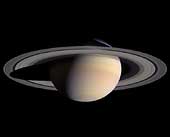
|
Table of Contents |
|
Cassini At Saturn
|
|
Saturn's Moons |
|
Atlas,
Calypso,
Dione,
Enceladus,
Epimetheus,
Helene,
Hyperion,
Iapetus,
Janus,
Mimas,
Pan,
Pandora,
Phoebe,
Prometheus,
Rhea,
Telesto,
Tethys,
Titan,
Possible New Satellites |
|
Saturn Science |
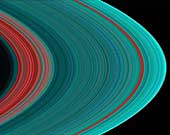 Saturn's A Ring From the Inside Out
Saturn's A Ring From the Inside Out
The best view of Saturn's rings in the ultraviolet indicates there is more
ice toward the outer part of the rings, than in the inner part, hinting at
the origins of the rings and their evolution.
Images taken during the Cassini spacecraft's orbital insertion on June 30 show compositional variation in the A, B and C rings. From the inside out, the "Cassini Division" in faint red at left is followed by the A ring in its entirety. The Cassini Division at left contains thinner, dirtier rings than the turquoise A ring, indicating a more icy composition. The red band roughly three-fourths of the way outward in the A ring is known as the Encke gap.
The ring system begins from the inside out with the D, C, B and A rings followed by the F, G and E rings. The red in the image indicates sparser ringlets likely made of "dirty," and possibly smaller, particles than in the icier turquoise ringlets.
This image was taken with the Ultraviolet Imaging Spectrograph instrument,
which is capable of resolving the rings to show features up to 97
kilometers (60 miles) across, roughly 100 times the resolution of
ultraviolet data obtained by the Voyager 2 spacecraft.
(Courtesy NASA/JPL/University of Colorado)
 Saturn's C and B Rings From the Inside Out
Saturn's C and B Rings From the Inside Out
Images taken during the Cassini spacecraft's orbital insertion on June 30
show definite compositional variation within the rings.
This image shows, from left to right, the outer portion of the C ring and inner portion of the B ring. The B ring begins a little more than halfway across the image. The general pattern is from "dirty" particles indicated by red to cleaner ice particles shown in turquoise in the outer parts of the rings.
The ring system begins from the inside out with the D, C, B and A rings followed by the F, G and E rings.
This image was taken with the Ultraviolet Imaging Spectrograph instrument,
which is capable of resolving the rings to show features up to 97
kilometers (60 miles) across, roughly 100 times the resolution of
ultraviolet data obtained by the Voyager 2 spacecraft.
(Courtesy NASA/JPL/University of Colorado)
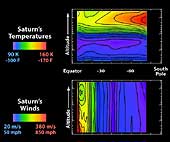 High Above Saturn's Cloud Tops
High Above Saturn's Cloud Tops
These graphs illustrate wind strength (bottom) and temperature above
Saturn. The data were acquired by the Cassini spacecraft's composite
infrared spectrometer when Saturn had just begun summer in its southern
hemisphere. Altitude increases in the upward direction, and Saturn's
south pole is to the right. The color red indicates higher temperatures,
and stronger winds.
As the top graph show, temperatures are cooler in the troposphere (the layer just above the cloud deck). In the upper stratosphere (the layer above the troposphere), temperatures increase toward the south pole. Temperature variation is muted in the upper troposphere.
These observed temperature changes allow the east-west winds to be determined. The measured cloud-top winds from NASA's Voyager mission have also been used to create this wind plot. This is the first time that the stratospheric winds have been determined. They show a marked decline of about 140 meters per second (approximately 300 miles per hour) at low latitudes, moving from the cloud tops to higher levels. The origin of this decay, or wind speed reduction, is not known.
Temperature maps obtained in the future from Cassini's new position in
orbit around Saturn will have higher latitude resolution, and are expected
to show more detail, helping us to unravel the riddles of Saturn's winds
above the cloud tops.
(Courtesy NASA/JPL/GSFC)
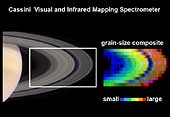 The Stuff of Rings
The Stuff of Rings
Evidence from the visual and infrared mapping spectrometer on the Cassini
spacecraft indicates that the grain sizes in Saturn's rings grade from
smaller to larger, related to distance from Saturn. Those data (right)
are shown next to a corresponding picture of the rings taken by Cassini's
narrow angle camera.
Saturn's rings are thought to be made up of boulder-size snowballs. By looking at the rings with the visual and infrared mapping spectrometer, the size of the ice crystals, or grains, on the surfaces of those boulders can be determined.
This visual and infrared mapping spectrometer has a spatial resolution similar to that of the human eye, so it provides a view analogous to standing on the spacecraft. Only instead of looking at the rings in visible wavelengths, the instrument sees wavelengths beyond what human eyes can see, ranging from the ultraviolet to the infrared.
The latest observations show that grain sizes range from very small, like powdery snow on Earth, to larger grains, like more granular snow.
The visual and infrared mapping spectrometer can also see the fingerprint
signatures of chemical bonds, and, in this case, it spotted the bonds of
frozen water molecules. Saturn's rings are made mostly of water in the
form of ice. While this has been known for many years, the Cassini data
are showing that the ring ice is more pure than previously thought, with
the most pure ices generally being observed at increasing distances from
Saturn.
(Courtesy NASA/JPL/University of Arizona)
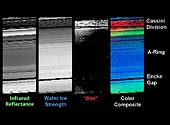 'Dirty Rotten' Rings
'Dirty Rotten' Rings
The visual and infrared mapping spectrometer on the Cassini spacecraft
has found evidence for a material dubbed "dirt" in Saturn's rings. The
observations indicate that some type of sorting mechanism is concentrating
this unidentified material in the gaps between the rings.
The images here show the rings just after Cassini successfully entered Saturn's orbit. The infrared reflectance image shows the brightness of scattered light transmitted through the rings. The thicker parts of the rings block more light, while the thinner parts, like the Cassini Division, let more light through. Assuming the rings are made of boulders, they might appear as a multitude of tiny moons.
The water ice strength image shows the amount of water in the rings, which appears to peak in the region of the A ring.
The "dirt" image shows that the so-called dirty material is most abundant in the thinnest parts of the rings: the Cassini Division, in the Encke and in other small gaps. This material appears remarkably similar to what Cassini measured on Saturn's moon, Phoebe.
This color composite is a slightly smeared image in which multiple
measurements of the same radial distance are repeatedly measured as
indicated by the shallow diagonal banding. For example, the five red
dots in the Encke Gap are repeated measurements of the inner edge of the
gap.
(Courtesy NASA/JPL/University of Arizona)
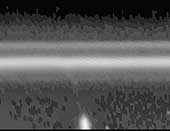 Streaming F Ring
Streaming F Ring
This image taken by the narrow angle camera on the Cassini spacecraft
shows Saturn's F ring. It was re-projected to appear as a straight line.
The bright object to the lower left is the moon Prometheus, which appears
elongated due to the re-projection. A faint stream of material, or
streamer, appears to be connecting the moon to the ring. This streamer
probably formed when Prometheus bobbed up and down in its orbit around
Saturn and caused periodic perturbations to the F ring.
The vertical scale is from 139, 000 kilometers to 141,000 kilometers
(86,300 miles to 87,600 miles). The horizontal scale is 20 degrees, or
one-eighteenth of the entire F ring. This image was taken in mid-June,
2004.
(Courtesy NASA/JPL/Space Science Institute)
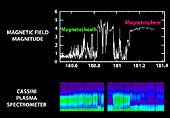 Entering the Magnetic Bubble
Entering the Magnetic Bubble
This graph illustrates the Cassini spacecraft's transition into Saturn's
magnetosphere from an outer region called the magnetosheath. A
magnetosphere is a magnetic envelope of charged particles that surrounds
some planets, including Earth. In between it and a boundary called the
bow shock -- where solar winds bend to avoid the magnetosphere -- is an
area called the magnetosheath.
These data (bottom panel) were taken by Cassini's plasma spectrometer,
which measures the energy and electric charge of particles such as
protons and electrons. In this graph, the color green represents the
highest intensity particles. The top panel shows the strength of the
magnetic field as measured by the dual technique magnetometer instrument
on Cassini. The field intensified as Cassini entered the magnetosphere.
(Courtesy NASA/JPL/Southwest Research Institute/Imperial College London)
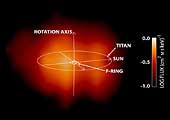 Behold Saturn's Magnetosphere!
Behold Saturn's Magnetosphere!
Saturn's magnetosphere is seen for the first time in this image taken by
the Cassini spacecraft on June 21, 2004. A magnetosphere is a magnetic
envelope of charged particles that surrounds some planets, including
Earth. It is invisible to the human eye, but Cassini's Magnetospheric
Imaging Instrument was able to detect the hydrogen atoms (represented in
red) that escape it. The emission from these hydrogen atoms comes
primarily from regions far from Saturn, well outside the planet's rings,
and perhaps beyond the orbit of the largest moon Titan.
The image represents the first direct look at the shape of Saturn's magnetosphere. Previously, NASA's Voyager mission had inferred what Saturn's magnetosphere would look like in the same way that a blind person might feel the shape of an elephant. With Cassini, the "elephant" has been revealed in a picture. This picture was taken by the ion and neutral camera, one of three sensors that comprise the magnetosphereic imaging instrument, from a distance of about 3.7 million miles (about 6 million kilometers) from Saturn.
The magnetospheric imaging instrument will continue to study Saturn's
magnetosphere throughout the mission's four-year lifetime.
(Courtesy NASA/JPL/John Hopkins University)
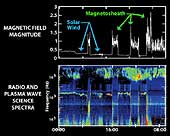 Entering Saturn's Magnetosphere with a Boom
Entering Saturn's Magnetosphere with a Boom
This graph illustrates the series of sonic booms that took place when the
Cassini spacecraft crossed Saturn's bow shock. A bow shock is a shock wave
located where incoming solar wind meets a planet's magnetosphere, or
magnetic bubble. Differences in electrical charges cause the solar wind
to curve around the magnetosphere in the same way that air flows around a
supersonic airplane. The resulting turbulence is heard as a sonic boom and
is represented here as an increase in wave frequency.
Scientists were surprised to discover that Saturn's bow shock was located at a distance of 3 million kilometers (1.9 million miles) from Saturn, much farther out than they had predicted.
Because the bow shock acts like a balloon when hit, oscillating in and
out, Cassini actually crossed it several times, resulting in the seven
sonic booms depicted above. Red denotes louder waves, and blue quieter.
This data was taken by Cassini's radio and plasma wave science instrument.
(Courtesy NASA/JPL/University of Iowa)
 Wide View of Saturn's F Ring
Wide View of Saturn's F Ring
This is one of the first images taken of Saturn's F ring by the Cassini
spacecraft after it successfully entered Saturn's orbit. It was taken by
the spacecraft's wide angle camera and shows the sunlit side of the rings.
(Courtesy NASA/JPL/Space Science Institute)
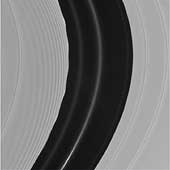 The Encke Gap as Never Seen Before
The Encke Gap as Never Seen Before
This image shows in superb detail the region in Saturn's rings known as
the Encke Gap. It was taken by the narrow angle camera on the Cassini
spacecraft after successful entry into Saturn's orbit. The view shows
the sunlit side of the rings.
(Courtesy NASA/JPL/Space Science Institute)
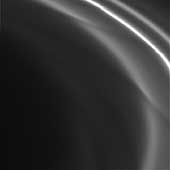 Cassini's First Picture of F Ring
Cassini's First Picture of F Ring
This is one of the first images taken of Saturn's F ring by the Cassini
spacecraft after it successfully entered Saturn's orbit. It was taken by
the spacecraft's narrow angle camera and shows the sunlit side of the
rings.
(Courtesy NASA/JPL/Space Science Institute)
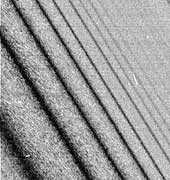 Rings Full of Waves (zoom)
Rings Full of Waves (zoom)
This image shows a close-up view of a density wave in Saturn's A ring. It
was taken by the narrow angle camera on the Cassini spacecraft after
successful entry into Saturn's orbit. The view shows the dark, or unlit,
side of the rings.
(Courtesy NASA/JPL/Space Science Institute)
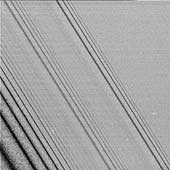 Rings Full of Waves
Rings Full of Waves
This image shows three density waves in Saturn's A ring. It was taken by
the narrow angle camera on the Cassini spacecraft after successful entry
into Saturn's orbit. The view shows the dark, or unlit, side of the rings.
(Courtesy NASA/JPL/Space Science Institute)
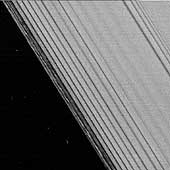 Rippling Rings
Rippling Rings
This is one of the first images taken by the Cassini spacecraft after it
successfully entered Saturn's orbit. It was taken by the spacecraft's
narrow angle camera.
(Courtesy NASA/JPL/Space Science Institute)
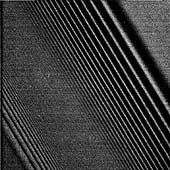 Two Waves in One Spectacular Image of Saturn's Rings
Two Waves in One Spectacular Image of Saturn's Rings
This image shows a bending wave (right) and density wave in Saturn's A
ring, interior to the Encke Gap. It was taken by the narrow angle camera
on the Cassini spacecraft after successful entry into Saturn's orbit. The
view shows the dark, or unlit, side of the rings.
(Courtesy NASA/JPL/Space Science Institute)
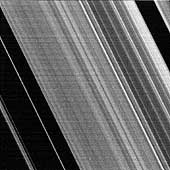 Cassini Captures the Cassini Division
Cassini Captures the Cassini Division
This image shows the region of Saturn's rings known as the Cassini
Division. It was taken by the narrow angle camera on the Cassini
spacecraft after successful entry into Saturn's orbit. The view shows
the dark, or unlit, side of the rings.
(Courtesy NASA/JPL/Space Science Institute)